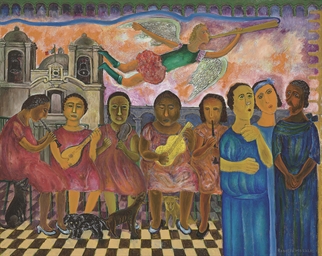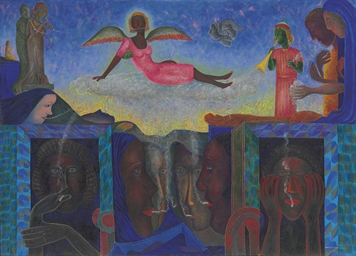Rodolfo Morales Untitled n.d. oil on canvas 47 1/4 x 60 3/4 in. (120 x 154.3 cm) Signed "RODOLFO MORALES" lower right.
Provenance Acquired directly from the artist Private Collection, California Acquired from the above by the present owner Catalogue Essay The work of Rodolfo Morales embodied by this vibrant and opulent painting, has left a resounding legacy for future Mexican artists: a unique vision of an intimate quotidian reality, mingled with fantastical elements of Surrealism. Ultimately the message conveyed is one of a specific reality visible to only the artist, which he formulated from his experiences in Mexico City, Oaxaca and his home town of Ocatlán. Although his work exudes a certain naïvete, on a deeper level it reflects a profound understanding of art history coupled with masterful technique. To understand Rodolfo Morales’s work, it is essential to contextualize his painting within the Mexican art world from the 1950s through the 1970s. During this time, there was a certain feeling of disillusionment within the art establishment of Mexico, expressed by a rejection of the state supported vision of mexicanidad in the visual arts, such as paintings glorifying the lives of the common people and other staples of Mexican aesthetics that were now beginning to be viewed with skepticism and disregard. Artists now wanted to be accepted and viewed at an international level and to surpass the legacy of “Los tres grandes” (Diego Rivera David Alfaro Siqueiros and José Clemente Orozco , whose murals had dominated the idea of Mexican art for decades. Concurrently, the rise of Abstract Expressionism in the United States portended the end of Europe, and particularly Paris, as being seen as the center of the art world. Thus, this tension in addition to a number of outside influences created a movement within Mexico in which a myriad of artistic approaches flourished and came to be known as La ruptura (The Rupture). La ruptura proved to be incredibly experimental and was made up of a myriad of styles and ideologies. The only clear principle that unified all Mexican artists within this group was a desire to be avant-garde by breaking away from the “typical Mexican art,” which was becoming increasingly considered passé. Within this context, Rodolfo Morales was already building a remarkable body of work that was considered anything but the norm. He had studied at the famous Academy of San Carlos in Mexico City, where he taught drawing classes for thirty two years to an average of three hundred students at a time. It was not until a mature age that he staged his first one-person exhibition at the Palacio Provincial in Málaga, Spain and two years later at the Casa de las Campanas in Cuernavaca. This attention to Morales’s art was in many ways thanks to Rufino Tamayo who discovered the artist and encouraged him to exhibit. Tamayo championed Morales’s work and announced in the catalogues of these first exhibitions that Morales brought a breath of fresh air to Mexican painting. The essence of his work lies in the fact that his subject matter always dealt with his own realities and the quotidian aspects of his life in Oaxaca, Mexico City and Ocotlán in particular. He began dedicating himself full time to painting in 1950, and his personal style was already evinced in these early works, echoing domestic scenes of his native town of Ocotlán. The women of Ocatlán, in particular, would become a constant and enduring element throughout his oeuvre. To further understand the worlds that Morales created in his baroque canvases, such as the present lot, it is essential to visualize his hometown of Ocatlán, located at the crossroads of several highways, which only comes alive during an important market day held every Friday. Other than this day, the town could be considered rather lifeless. Morales remembered that during his childhood the liveliest place in Ocatlán was the town jail, where boisterous prisoners would craft handmade baskets. Morales himself lived in a large 17th century house in the center of town, which he often depicted in his paintings. One of the
Rodolfo Morales Untitled n.d. oil on canvas 47 1/4 x 60 3/4 in. (120 x 154.3 cm) Signed "RODOLFO MORALES" lower right.
Provenance Acquired directly from the artist Private Collection, California Acquired from the above by the present owner Catalogue Essay The work of Rodolfo Morales embodied by this vibrant and opulent painting, has left a resounding legacy for future Mexican artists: a unique vision of an intimate quotidian reality, mingled with fantastical elements of Surrealism. Ultimately the message conveyed is one of a specific reality visible to only the artist, which he formulated from his experiences in Mexico City, Oaxaca and his home town of Ocatlán. Although his work exudes a certain naïvete, on a deeper level it reflects a profound understanding of art history coupled with masterful technique. To understand Rodolfo Morales’s work, it is essential to contextualize his painting within the Mexican art world from the 1950s through the 1970s. During this time, there was a certain feeling of disillusionment within the art establishment of Mexico, expressed by a rejection of the state supported vision of mexicanidad in the visual arts, such as paintings glorifying the lives of the common people and other staples of Mexican aesthetics that were now beginning to be viewed with skepticism and disregard. Artists now wanted to be accepted and viewed at an international level and to surpass the legacy of “Los tres grandes” (Diego Rivera David Alfaro Siqueiros and José Clemente Orozco , whose murals had dominated the idea of Mexican art for decades. Concurrently, the rise of Abstract Expressionism in the United States portended the end of Europe, and particularly Paris, as being seen as the center of the art world. Thus, this tension in addition to a number of outside influences created a movement within Mexico in which a myriad of artistic approaches flourished and came to be known as La ruptura (The Rupture). La ruptura proved to be incredibly experimental and was made up of a myriad of styles and ideologies. The only clear principle that unified all Mexican artists within this group was a desire to be avant-garde by breaking away from the “typical Mexican art,” which was becoming increasingly considered passé. Within this context, Rodolfo Morales was already building a remarkable body of work that was considered anything but the norm. He had studied at the famous Academy of San Carlos in Mexico City, where he taught drawing classes for thirty two years to an average of three hundred students at a time. It was not until a mature age that he staged his first one-person exhibition at the Palacio Provincial in Málaga, Spain and two years later at the Casa de las Campanas in Cuernavaca. This attention to Morales’s art was in many ways thanks to Rufino Tamayo who discovered the artist and encouraged him to exhibit. Tamayo championed Morales’s work and announced in the catalogues of these first exhibitions that Morales brought a breath of fresh air to Mexican painting. The essence of his work lies in the fact that his subject matter always dealt with his own realities and the quotidian aspects of his life in Oaxaca, Mexico City and Ocotlán in particular. He began dedicating himself full time to painting in 1950, and his personal style was already evinced in these early works, echoing domestic scenes of his native town of Ocotlán. The women of Ocatlán, in particular, would become a constant and enduring element throughout his oeuvre. To further understand the worlds that Morales created in his baroque canvases, such as the present lot, it is essential to visualize his hometown of Ocatlán, located at the crossroads of several highways, which only comes alive during an important market day held every Friday. Other than this day, the town could be considered rather lifeless. Morales remembered that during his childhood the liveliest place in Ocatlán was the town jail, where boisterous prisoners would craft handmade baskets. Morales himself lived in a large 17th century house in the center of town, which he often depicted in his paintings. One of the

.jpg)
.jpg)












Try LotSearch and its premium features for 7 days - without any costs!
Be notified automatically about new items in upcoming auctions.
Create an alert